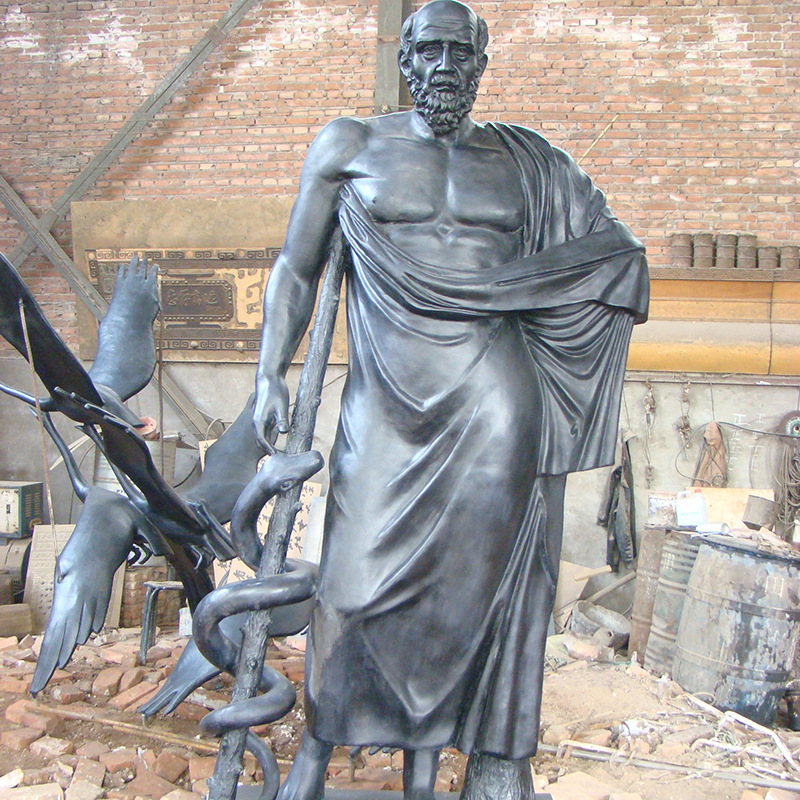A Roman-period bronze statue of Aesklepius, god of healing. He holds the serpent-entwined staff, also known as a caduceus, which still remains the world-recognized symbol of medicine and healing to this day.
The Aesklepius statue is a testament to the ancient Romans’ belief in the power of medicine and healing. His staff, entwined by serpents, is a symbol of renewal and rebirth, a reminder that even in the face of illness or injury, there is always hope for recovery. This image captures the essence of Aesklepius’s role as the god of healing, and it is a powerful symbol of medicine’s role in human life.
In our modern world, the caduceus remains the symbol of the medical profession. It appears on hospitals and clinics, in medical textbooks and on the walls of doctors’ offices. Its presence is a silent reminder of the profession’s commitment to healing and拯救生命.
The serpents in the caduceus symbolize renewal and rebirth, just as the god Aesklepius represents the hope for recovery from sickness or injury. This symbol has also come to represent the unending quest for knowledge and understanding in the field of medicine. The serpents’ coils represent the complexity of the human body and the infinite possibilities of medical research.
As we look to the Aesklepius statue, we are reminded of our own place in the grand scheme of things. We are fragile beings, subject to the whims of fate and circumstance, yet we have within us the ability to overcome even the most insurmountable obstacles. The god of healing reminds us that in times of sickness or struggle, there is always hope for recovery.The Aesklepius statue also serves as a reminder of the role of art in our understanding of history and culture. It is through the lens of art that we can gain a deeper appreciation of the rich tapestry of human experience. The statue’s intricate details and the craftsmanship that went into its creation offer a window into the minds and hearts of the ancient Romans.
Moreover, the Aesklepius statue prompts us to reflect on our own relationship with medicine and healing. In an age where advanced technology and scientific knowledge have greatly expanded our understanding of the human body and its potential for recovery, we must not forget the central role that doctors, surgeons, and medical professionals play in our well-being. They are the modern-day descendants of Aesklepius, charged with the sacred duty of healing and saving lives.
In conclusion, the Aesklepius statue is more than just a piece of bronze art from the Roman period; it is a symbol of hope, resilience, and the never-ending human quest for knowledge and understanding. As we gaze upon this timeless masterpiece, we are reminded of our shared humanity and the role that medicine plays in ensuring our physical well-being. In this way, the Aesklepius statue serves as a testament to the enduring power of both art and medicine in shaping our world.The Aesklepius statue also serves as a bridge between the ancient world and our modern society, bridging the gap between past and present. It reminds us that, despite the advancements in technology and medical science, the fundamental human experiences of sickness, injury, and recovery remain unchanged. The statue reminds us that the role of doctors and healers has always been, and will always be, integral to our survival and well-being.
Furthermore, the Aesklepius statue prompts us to question our own views on medicine and health. In a world where we often take for granted the availability of modern medical care, we must remember that access to quality healthcare is not universal. Many parts of the world still lack basic medical facilities and resources, and countless individuals continue to suffer from preventable diseases and injuries. The Aesklepius statue serves as a reminder of the importance of advocating for universal access to healthcare and striving to ensure that every individual has equal access to life-saving treatments and services.
In addition, the Aesklepius statue prompts us to reflect on our role as individuals in promoting wellness and preventing illness. Beyond relying on doctors and healers for treatment, we must also take responsibility for our own health and well-being. We should prioritize preventative healthcare, engage in regular physical activity, adopt healthy lifestyle habits, and seek medical attention promptly when ill or injured. By taking ownership of our own health, we can contribute to improving the overall well-being of our communities and reducing the burden on medical professionals.
In conclusion, the Aesklepius statue offers us a profound lesson in history, medicine, and society. It reminds us that medicine is not just about curing illnesses; it is also about ensuring equitable access to healthcare and promoting wellness. As we stand in awe of this ancient masterpiece, let us remember its legacy and apply its lessons to our own lives, striving to create a healthier and more equitable world for generations to come.


